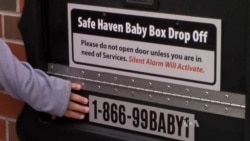About 150 babies in the United States are abandoned each year in creeks, along roadsides and in trash cans, according to child advocates.
One such baby was a newborn girl, found off a snowy trail in an Indianapolis, Indiana, park.
Linda Znachko, whose ministry buries abandoned infants, named the baby Amelia Grace Hope. She believes Amelia didn’t have to die.
That's because there was a Safe Haven location not far from where Amelia was found.
A safe space for unwanted infants
Since 2008, legal guardians throughout the United States have been allowed to surrender infants 45 days or younger to any emergency medical service provider, without fear of prosecution.The policy has been the law in Indiana since 2000.
The law was passed for mothers like Amelia's, who, Znachko says, "didn’t want to be identified."
"If that mother, maybe an under-resourced, desperate mom, who was terribly afraid, would have been able to find her way just two miles down the road, she may have been able to surrender that baby and that baby could be alive today."
Monica Kelsey, who was herself abandoned as an infant and now works as a firefighter, felt she had to do something.
She found the answer while visiting a South African church, which had a baby safe.
The metal boxes, with padded interiors, have a climate-controlled thermostat that adjusts the temperature inside according to the weather outside. When a baby is placed in the box, it triggers an infrared beam and a series of silent alarms, which notify emergency personnel within a minute.
So Kelsey created Safe Haven Baby Boxes in the U.S.
Kelsey had met Znacho because of Amelia's case, so they worked together to lobby the state legislature to amend the Safe Haven law to protect people who use the boxes, as well as those dropping infants off in person.
In memory of one lost child, Amelia become a small but important part of the program: her footprint was used in the organization’s logo.
Changing laws to protect babies
Initially, the Indiana State Department of Health opposed the plan.
In a report, it cautioned against using a system with no standards or protocols.
"I offered them the reality that I have seen the autopsy results of the conditions of these babies when they are found.It’s so tragic.It's so hard to read — that even if a baby were to die in the baby box, it would be an attempted rescue on their life."
Safe Haven Baby Boxes strengthened its program by adding an automatic lock to the outside of the boxes so that only emergency personnel could remove the newborns from the interior door.
The legislature unanimously amended the law.
Kelsey's husband, Joe Kelsey, approved the first box installation in April at the local fire station in Woodburn, Indiana, where he serves as mayor.
"I’m very proud that Woodburn is the first city to have Safe Haven Baby Boxes, and if one life is saved during the whole term that I’m mayor, it will be the best thing," Kelsey said.
The Knights of Columbus fraternal organization paid for the first 100 boxes, which cost about $2,000 each.
Monica Kelsey receives dozens of emails a day from people all over the country asking for a box in their city. The next three locations have already been selected, for high-abandonment areas in Indiana.
Kelsey says her initial goal is to save "10 percent of these babies that are being abandoned," by convincing people to put them in boxes; but, that's just "where we're going to start," she says."I think through the years, though, that number is going to grow. And eventually, hopefully, save 100 percent of the babies that are being illegally abandoned."












